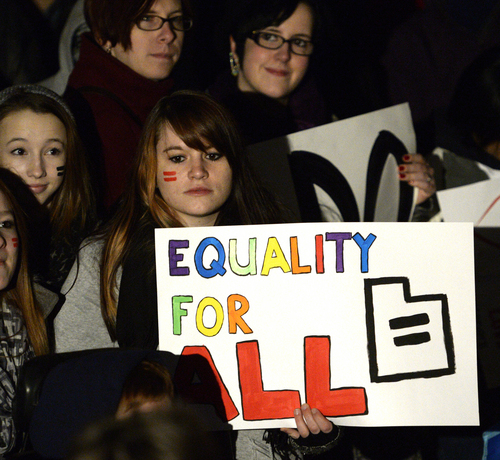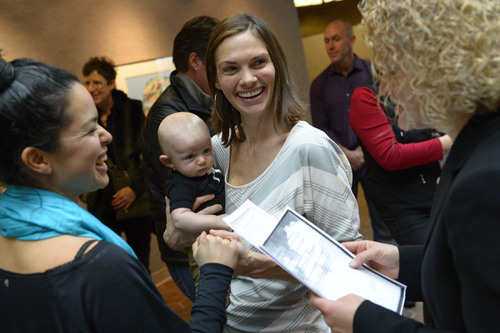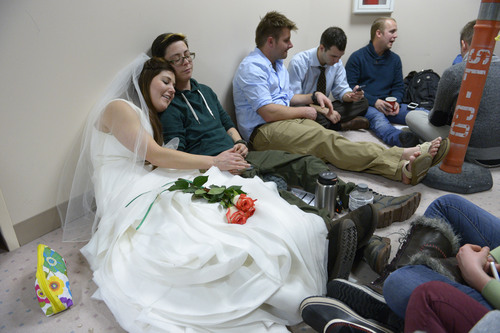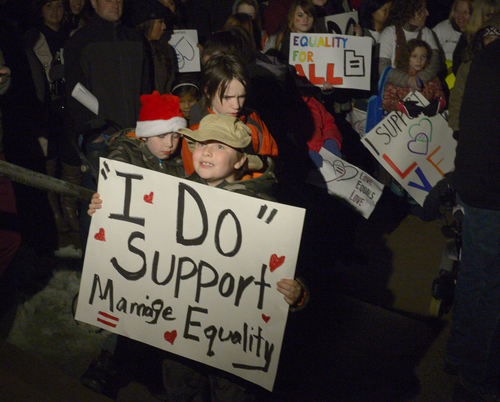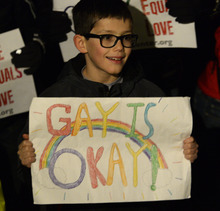This is an archived article that was published on sltrib.com in 2013, and information in the article may be outdated. It is provided only for personal research purposes and may not be reprinted.
The state of Utah so far has banked much of its legal argument against same-sex marriage on the assertion that such unions threaten the traditional, "age-old and still predominant," form of marriage: heterosexual, monogamous marriage.
That marriage form, the state says, has been the norm for Utah since its "very existence as a state" and it should not have to abandon the "deeply rooted definition of marriage as the union of a man and a woman for a genderless definition that severs the link between marriage and the vital societal purposes it has always and everywhere served."
It has proved to be a shaky argument.
In two different rulings — one legalizing same-sex marriage and the other decriminalizing polygamy — federal judges commented on the state's claims about traditional marriage and its efforts to bar or penalize certain groups of people interested in committed relationships.
On Dec. 13, U.S. District Judge Clark Waddoups, who struck a clause from Utah's bigamy law that criminalized polygamy, found it ironic that: "At a time of much discussion in society about problems arising from the decline in rates of people marrying or the increased age at which people decide to marry, the [bigamy] statute penalizes people for making a firm marriage-like commitment to each other, even though they know that their religious cohabitation does not result in state-sanctioned or recognized marriages."
And there's this sticky point: It is accurate to say that polygamy — which the federal government 134 years ago barred the state from sanctioning — is the marriage form "found in more places and at more times than any other," as marriage historian Stephanie Coontz notes in her book, "Marriage, A History: from Obedience to Intimacy or How Love Conquered Marriage."
A week after Waddoups issued his decision, U.S. District Judge Robert J. Shelby dinged the state's traditional-marriage argument, centered on responsible procreation and child rearing, as he found Utah's ban on same-sex marriage unconstitutional.
"The traditional view of marriage has in the past included certain views about race and gender roles that were insufficient to uphold laws on those views," Shelby noted. He also observed that "tradition alone cannot form a rational basis for a law."
Shelby went on to quote from U.S. Supreme Court Justice Antonin Scalia's dissent in Lawrence v. Texas that " 'preserving the traditional institution of marriage' is just a kinder way of describing the state's moral disapproval of same-sex couples."
In motions requesting a stay from the 10th Circuit Court of Appeals, the state reiterated the "age-old" and "historic understanding of marriage as only the legal union of one man and one woman," its rational interest in regulating sexual relationships and child-rearing, and its concern that Shelby failed to "consider history and tradition."
But, according to historian Nancy Cott, if there is anything traditional about marriage, it is its ability to adapt to changing social and ethical needs.
"Societal change over the centuries has produced new features in marriage that are commonly accepted today, although they would have been unthinkable at the founding of the United States," Cott said in a court document submitted by plaintiffs in the same-sex marriage lawsuit in Utah.
Cott, a Harvard professor and author of "Public Vows: A History of Marriage and the Nation," prepared the affidavit for a same-sex marriage lawsuit still pending in Nevada.
At the nation's founding, traditional marriage was based on a "legal fiction" that married couples were one entity, led by a husband with sole legal, economic and political representation rights, she said.
"Far from viewing marriage as immutable, courts and legislatures altered marriage fundamentally in order to take account of societal needs and spouses' evolving relationships within their households and in the larger society," she said in the court filing. It has endured as an institution because it is "flexible and resilient, not static."
Among the societal shifts that have changed "norms" of marriage: economic and gender equality for women; acceptance of interracial marriage; and changes in divorce laws.
"Many features of modern marriage that we take for granted today — such as the ability of both spouses to act as individuals, to marry someone of another race, or to divorce for numerous reasons — were fiercely resisted as they were coming into being, and were viewed by opponents as threatening to destroy the institution of marriage itself," Cott said in her affidavit.
Utah was among a majority of states that did not permit interracial marriages, a law adopted in 1852 — the same year The Church of Jesus Christ of Latter-day Saints publicly acknowledged polygamy as a key tenet of the faith. Utah repealed its anti-miscegenation statute in 1963.
Such laws were often justified on the basis that interracial marriage was "against nature or against the Divine plan," Cott said in her affidavit. "They contended that permitting cross-racial couples to marry would fatally degrade the institution of marriage."
Likewise, critics of the expansion of divorce laws feared easy access would "undermine the marital compact entirely," she said.
Shelby said the state had provided no evidence that the number of opposite-sex couples choosing to marry would be affected "in any way" by the ability of same-sex couples to marry.
Shelby noted in his ruling that in an amicus brief submitted to the 9th Circuit Court of Appeals by the District of Columbia and 14 states that permit same-sex marriage, the states said the implementation of same-sex unions had not caused "any decrease in opposite-sex marriage rates, any increase in divorce rates, or any increase in the number of nonmarital births."
Shelby also focused on the state's argument that same-sex couples are distinct from opposite-sex couples because they are not able to naturally reproduce. Procreation, Shelby said, is not a defining characteristic of marriage and the state's argument demeans not just same-sex but opposite-sex couples who are unable to reproduce or choose to not have children.
It also disregards the fact that some gay couples do have children from previous relationships, as well as adoption and modern reproductive technology and practices, including surrogacy and artificial insemination, that have allowed gay couples to become parents.
According to Cott, states "bundled together" legal obligations and social rewards to "encourage couples to choose committed relationships of sexual intimacy over transient relationships, whether or not these relationships will result in children."
In fact, "the ability or willingness of couples to produce progeny has never been required for or necessary to marriage under the law of any American state," she said. "The notion that the main purpose of marriage is to provide an ideal or optimal context for raising children was never the prime mover in states' structuring of the marriage institution in the United States, and it cannot be isolated as the main reason for the state's interest in marriage today."
Cott said states' marriage rules are aimed more at supporting than producing children.
During oral arguments before the U.S. Supreme Court on the Proposition 8 case this summer, several justices zeroed in on procreation as a basis for a same-sex marriage ban.
"Suppose a state said that because we think the focus of marriage really should be on procreation, we are not going to give marriage licenses anymore to any couple where both people are over the age of 55," asked Justice Elena Kagan. "Would that be constitutional? … Because that's the same state interest … If you are over the age of 55, you don't help us serve the government's interest in regulating procreation through marriage."
Scalia then quipped that perhaps states could have questionnaires at "the marriage desk when people come in to get the marriage [license], you know, are you fertile or are you not fertile?"
Attorney Charles J. Cooper, who represented the citizens group who brought the petition challenging legalization of same-sex marriage in California, then explained that marriage was designed to "make it less likely that either party to that marriage will engage in irresponsible procreative conduct outside of that marriage."
Procreation aside, Cott opined that the exclusion of same-sex couples from equal marriage rights was at odds with the historical change in marriage in the United States and contemporary public policy that "marriage is a public good."
"Throughout American history, state legislatures and courts have made and altered laws governing the meaning and structure of marriage," she said. "Restrictions on marriage that were seen as necessary in their time have since been removed as unwarranted and/or unconstitutional."
What early Americans would recognize today, she added, is that marriage is still about freely choosing a partner, forming an economic partnership and a common household and having that relationship recognized by the state.
Twitter: @Brooke4Trib —
The family state
Utah leads the nation in many family-related markers: It has the most households headed by married couples, the nation's highest birthrate and the biggest families in the country. The state's divorce rate is also among the highest in the nation, ranked No. 4 in the country.
In a court document, state attorneys describe Utah as the "most child-centric of all states and the most successful in linking children to their mothers and fathers."
But Utah is tracking shifts observed across the nation in what is now the "norm" when it comes to marriage and childbirth. The age of first marriage in Utah has risen by about three years over the past decade and is currently 24 for women and 26 for men. Nationally, women marry at age 27 for the first time, while men on average are age 29.
In 2012, 19 percent of Utah births were to unmarried women, edging up from 17 percent a decade ago. Nationally, 41 percent of births are to unmarried women.
There were about 3,900 gay couples in Utah as of 2010, and they were raising approximately 2,900 children, according to court documents filed by the plaintiffs who challenged the state's same-sex marriage ban. The Williams Institute, based at UCLA's School of Law, estimated earlier this year that Salt Lake City has the highest percentage of same-sex couples raising children than any other metro area in the country.
Nationally, about 16 percent of all same-sex households included children of their own in 2011, according to the Census.
— Brooke Adams


